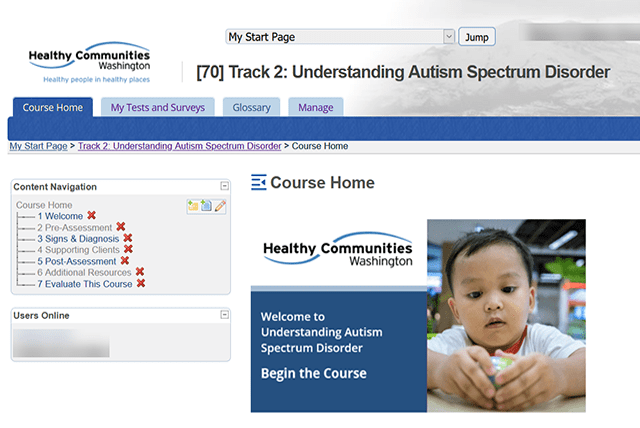Your agency has probably restructured at least some of its professional development programs as a result of the COVID-19 crisis. You may have shifted to online training or are at least holding some sessions via remote platforms like Zoom.
While it is handy to have a distance learning safety net to keep passing information on to your staff, this doesn’t guarantee your staff’s engagement and motivation. Times are tough, so they might not be engaged in the same way as usual.
Even in normal times, it’s tough to keep learners motivated in remote settings. For starters, visual cues are hard to read from a distance, so instructors have trouble responding on an individual basis. Another common issue is that many self-guided courses are lackluster and not tied to learning goals, so they can be hard for participants to follow. And cultural competency needs special attention in an online learning format.
How to motivate your staff to learn during an online training program
The secret to motivating learners is to hit them from all directions and ensure every step is designed to promote enthusiasm in what they’re learning.
In general terms, this means ensuring your staff knows why they’re taking training and that the value is clear. It also means giving them educational materials designed for adult learners. Grown-ups need to juggle competing demands, preferred learning styles, and their own familiarity with the delivery method.
Following is a list of ways you can create an environment that encourages learning and helps staff feel inspired to build their own skills.
1. Make sure that the training materials are relevant for their job.
Participation will drop like a stone if a course doesn’t make sense to the people taking it. Unfortunately, many courses are too general or not addressed to the right group. Learning new skills can keep employees engaged and dedicated to their jobs. It helps if you can merge training with staff learning goals.
It’s also important to consider whether the online training adjusts to your staff’s skill levels. Too-easy courses or content that feels repetitive make it hard for learners to stay motivated.
2. Get buy-in from supervisors.
Participants’ supervisors need to be included from the beginning. A supervisor can make sure employees participate and also help answer any questions that arise in the course. Consider enlisting superiors as coaches for the best results.
3. Build anticipation for the course.
A last-minute course announcement is more likely to land flat on its face than one your staff is expecting and excited about. If they’re already overwhelmed, your course will likely feel like another item in their miles-long to-do list rather than something to look forward to.
Treat your training launch with some showmanship. Deliver some teasers ahead of schedule that let participants know something exciting is coming up.
4. Give your staff time to familiarize themselves with the platform.
Online spaces are not everyone’s cup of tea. You may find that some of the people in your group are tech-savvy while others struggle to get the hang of technology and new software. To even the playing field and help everyone feel comfortable, open the virtual doors earlier than you need to and give everyone time to access the program without constraints, just to look around, understand the menu and interface, and get situated.
5. Promise a reward.
Some training needs to be done, no matter what, such as HIPAA or privacy rights. But you can tie a reward to successful completion in other modules. This might be a certificate of completion, some paid time off, new equipment for use on the job, additional training opportunities, or end-of-course lunches.
Of course, if your staff is leveling up, there’s something to be said about performance bonuses, salary increases, and even promotions resulting from extensive education.
6. Allow time in their schedule for learning.
For someone working full time, adding a course on top of their busy schedule is probably one of the biggest deterrents. To prevent this, allow some flexibility as a trade-off for committing to the online training.
An afternoon or a certain number of hours to complete the training can help if they have a busy schedule that competes for their attention.
7. Set benchmarks.
One of the biggest reasons your training may suffer is a lack of monitoring. After all, how will you and your staff measure success if you don’t know where you’re starting?
If your course is skills-based, first take measurements of where staff skills are. Tell your employees why their skills are being measured. Then upon completion, measure progress against your benchmark. One idea is to assess ability with one task during performance appraisals. Employees will also equate the course with an overall job requirement.
8. Share learning objectives.
For most of us, it’s difficult to work without a clear objective in mind. Even if it is something as simple as obtaining a state license. To help your staff stay committed to the training, frame the training by sharing what the course is about and give them a target. If they know what they should be learning ahead of time, that helps them know what they should focus on.
9. Ask learners to set their own goals.
Similar to the above tip, you can encourage remote learners to state what they want to get out of the course. Thinking about how the material fits in with their life can help make it more relevant.
10. Call and/or email all participants at the start of class.
If you’ve ever sat at the back of a massive classroom with several dozen students, you’re familiar with the feeling of not knowing if your professor was aware of your presence. This makes it easy to blend in the background and can lead to disengagement from the start.
To avoid this, connect with your staff and let them know that you hope to connect with them as an individual and are invested in their success in the course.
11. Cultivate a warm classroom where you, as the facilitator, are present and reachable.
Online training programs can be challenging because oftentimes when communicating through chat and email, we forget that there’s a person on the other side. To build rapport with your learners, provide your phone number and/or a frequently checked email account that your participants can rely on reaching you in a timely manner.
Many people are unsure of online learning and nervous about taking courses. This strategy helps overcome their fears and boosts their contribution.
12. Nominate a champion.
Encourage community participation by asking participants to elect an “Inspirational Class Captain” to post motivational quotes in each module. The blogging tool or the discussion Forum is a good place for this contribution.
13. Ask early and often what participants think.
A survey at the end of the course is a one good way to evaluate the success of your training program. Asking them throughout the course how the material relates to their work is even better. Learners will often forget details by the end of a course. Check in with polls that ask how relevant they think information is or how long it took them to complete a module. Also, create a forum designed for general thoughts, and ask your instructor to get in the habit of asking for feedback.
14. Talk to participants.
Offer Skype, Zoom, or chat sessions to participants on a weekly basis. Offering these as fixed office hours is a great way to motivate participants to ask questions they need immediate answers to and to engage with you when they otherwise might not have.
15. Be careful with feedback.
Provide consistent, positive feedback and frame all negative feedback with a positive tone.
16. Offer “extra credit” activities/games each week if possible.
Even if participants aren’t participating in the course for grades, short quizzes can be pitched as games that add a layer of fun to your online training and help to motivate the participants to continue on.
17. Include partners.
Create peer groups or peer partnerships to encourage collaboration and class participation. These could be community partners or interagency partners. You can use the Groups tool to create a private collaboration space.
18. Foster interaction between learners.
One of the best parts of in-person education is the opportunity to interact with classmates and get real-time feedback, answer questions, or simply talk through ideas relating to the course content. This is largely gone from online environments unless it is actively fostered.
One way to foster interaction among your learners without resorting to the dreaded team projects is by sparking debate and encouraging learners to share their own ideas and experiences as they relate to the topics you’re covering.
You can also try this strategy by creating so-called “Watercooler chat” rooms for people to connect freely.
19. Follow up with your online learners often.
Identify low participating participants and respond more to their posts to show that you’re tuned into them. Call and/or email participants who are not participating in class to show that you’re concerned about their presence in the classroom and offer support to help them succeed.
20. Give help.
Technology scares some people. Be prepared to make it easy to succeed in an online course. Read some more tips about making your course accessible for people who have visual or physical limitations. Set up a demonstration before the course begins. Appoint coaches in the workplace who can offer assistance. Give a computer literacy assessment before the course begins so you have a better idea of who will need additional help.
Originally published July 3, 2014, updated September 27, 2021.



